
How AI is Reshaping Lives in India, Singapore, Malaysia, and Thailand
The global landscape of artificial intelligence (AI) tools is experiencing rapid evolution, with notable usage across India, Singapore, Malaysia, and Thailand. This article highlights key findings from a survey of 4,121 respondents in these nations, focusing on the frequency of tool usage, types of tools utilized, purposes for use, levels of trust and concerns, Tangible impacts, and factors influencing attitudes toward AI technologies. As AI continues to reshape industries and societies, understanding these dynamics is essential for harnessing its full potential across diverse cultural contexts.
1. Demographic Overview
The demographic differences among respondents from India, Singapore, Malaysia, and Thailand provide valuable insights for understanding the research findings.
- Age Distribution: In India, the age group of 25-34 years is the most represented among respondents. Conversely, Singapore displays an older demographic, with a notable number of respondents aged 35-54. Both Malaysia and Thailand have a significant representation in the 35-44 age range, reflecting similar trends in these countries.
- Gender Composition: In India and Malaysia, there is a higher percentage of male respondents, while Singapore and Thailand have a more balanced gender distribution, with nearly equal male and female representation.
- Occupational Categories: All countries exhibit a significant number of full-time office workers, with India having the highest percentage of students. Singapore demonstrates strong representation in the full-time office worker category, while Thailand features a notable percentage of self-employed individuals. Additionally, Malaysia reports the highest percentage of unemployed or retired respondents, ranking second highest in this occupational category of this country.
The following infographic provides an overview of the demographic details:
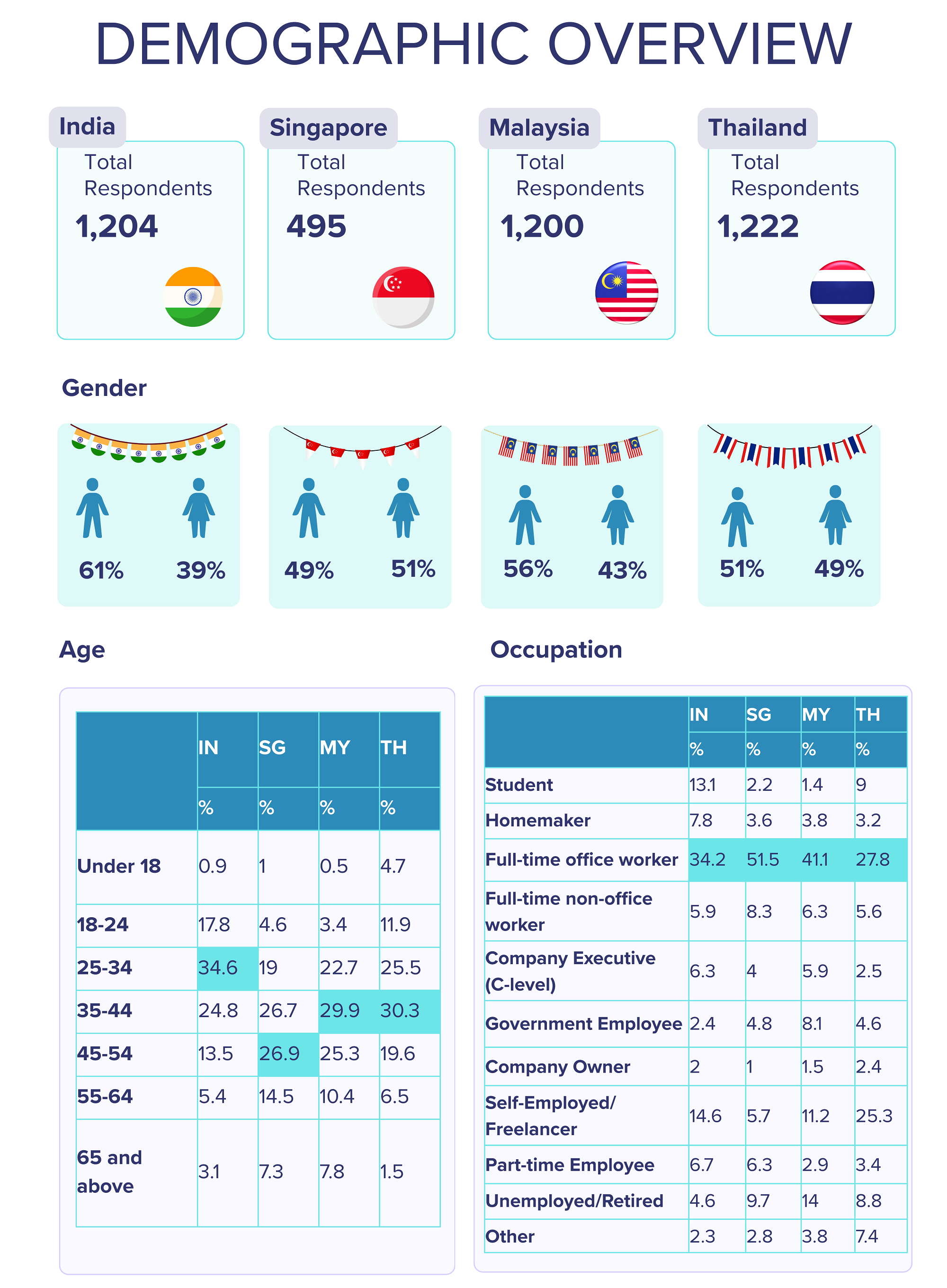
2. Frequency of AI Tool Usage
The adoption of AI tools varies significantly across countries, revealing intricate patterns in user engagement. Indian users stand out as the most active group, engaging with AI tools daily, while respondents from Thailand and Singapore follow closely behind, with Thailand demonstrating the highest frequency of weekly usage among these nations.
Conversely, a notable portion of users in Singapore and Malaysia report infrequent engagement, with Malaysia having the highest proportion of individuals who indicate they never use AI tools.
Demographic factors play a pivotal role in shaping these usage patterns. Singapore's aging population, particularly the notable number of respondents in the 45-54 age bracket, likely influences their interaction with technology, potentially leading to hesitancy in adopting new digital solutions. Moreover, Malaysia's higher percentage of unemployed or retired individuals adds another layer to the usage landscape. This group is notably less likely to engage with AI tools, suggesting that their current circumstances may hinder their access to and interest in adopting new technologies.
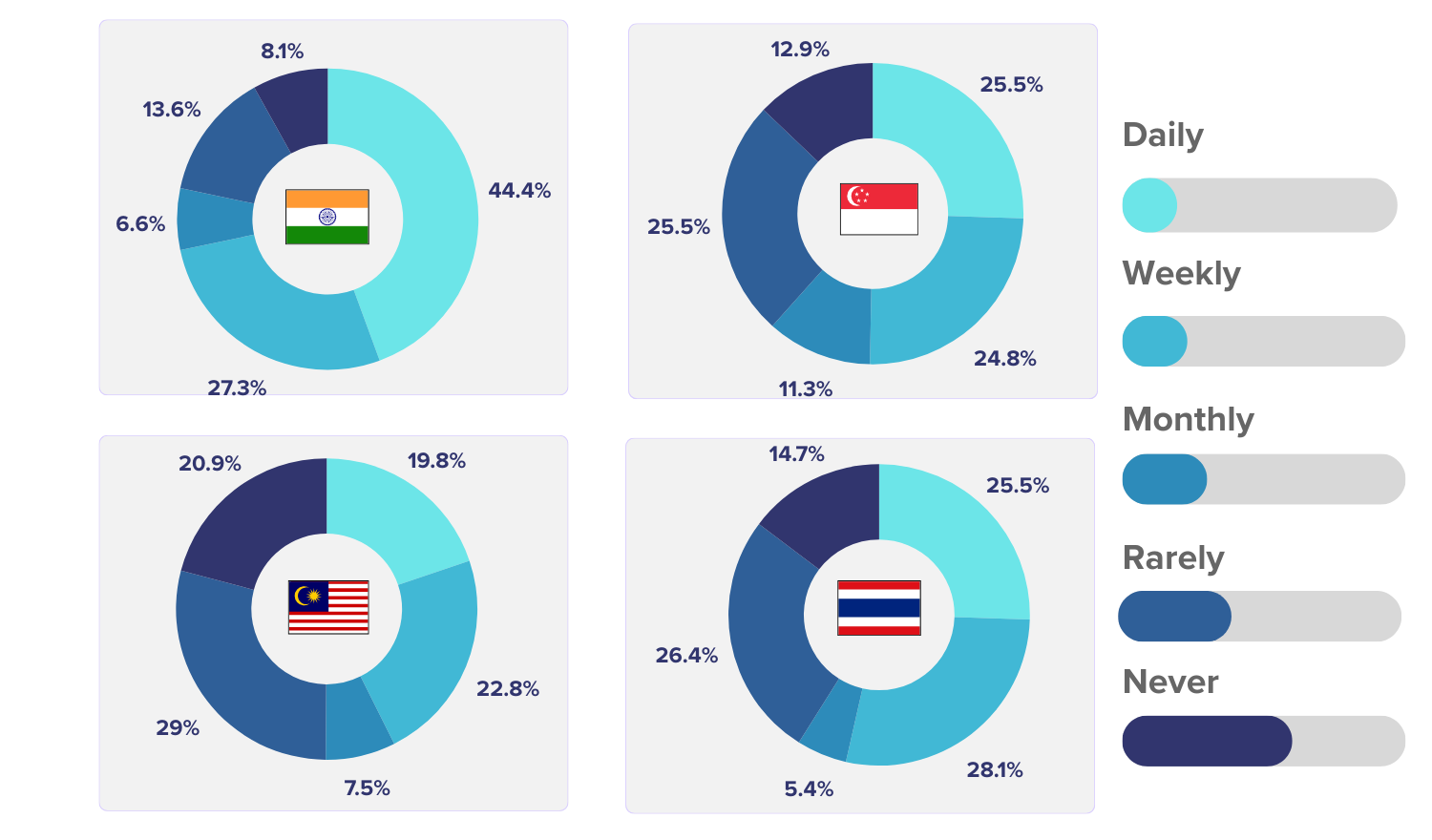
3. Types of AI Tools in Use
An analysis of the AI tools currently utilized across four countries—India, Singapore, Malaysia, and Thailand—reveals usage patterns, reflecting the technological engagement in each region.
- Conversational AI tools, such as ChatGPT and Microsoft Copilot, are the most widely used AI technologies across all four countries. Singapore leads with 56.4% of users engaging with these tools, followed closely by India at 55.6%. Malaysia has a slightly lower adoption rate at 50.1%, while Thailand reports the lowest usage at 41.9%. Notably, despite Singapore's older demographic—with a significant number of respondents in the 35-54 age bracket—engagement with conversational AI tools remains high.
- Virtual Assistants, such as Siri and Google Assistant, rank as the second most popular AI tools. Thailand leads with a usage rate of 44.5%, followed closely by India at 43.4%. In contrast, Singapore and Malaysia exhibit lower engagement at 28.5% and 29.4%, respectively. This trend corresponds with demographic factors, as both Thailand and India have a significant percentage of respondents in the younger age group of 18-34 years, suggesting that these younger populations are more inclined to adopt and utilize virtual assistant technologies compared to the older segments found in Singapore and Malaysia.
- AI-based chatbots for customer service represent the third most popular category of AI tools. India boasts the highest usage rate at 31.1%, followed by Singapore at 23.6%. Thailand comes next with a usage rate of 20.8%, while Malaysia has the lowest adoption at 15.5%. The relatively low usage of chatbots in Malaysia may be influenced by a higher percentage of unemployed or retired individuals who may not engage as frequently with digital customer service solutions.
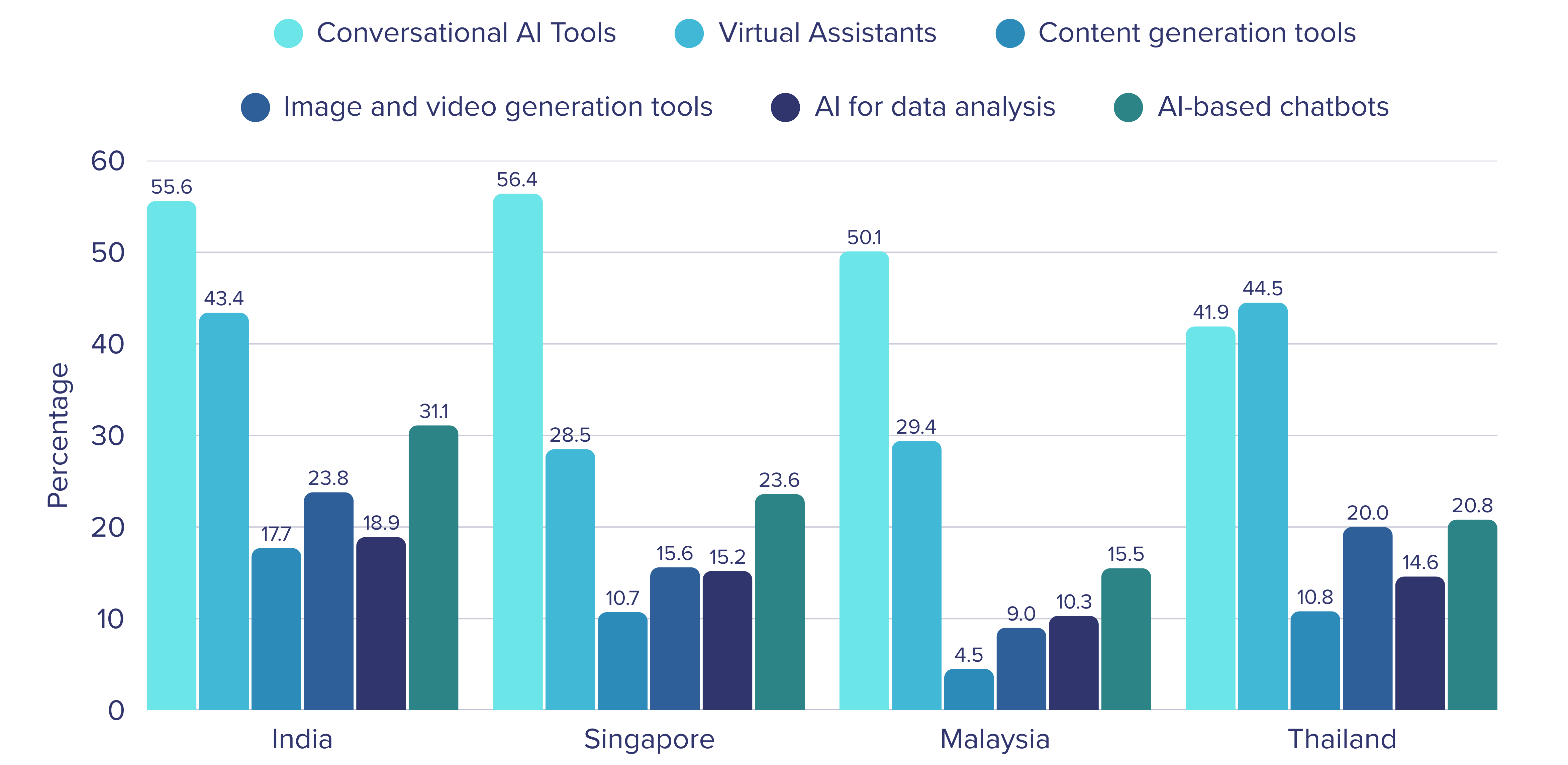
4. Primary Motivations for AI Tool Usage
The primary reasons for using AI tools reveal significant variations across the four countries and show a potential relationship with demographic factors. Educational purposes are the leading motivation, particularly in India (50.7%), which has a large representation of younger respondents in the 25-34 age group. Thailand follows closely at 40.5%, reflecting a similar trend. In Singapore, the older demographic (35-54 years) might influence a slightly lower engagement at 37.2%. Enhancing productivity emerges as another key reason, especially in Thailand (37.3%) and India (36.8%), but Malaysia lags behind at 24.9%, which could be impacted by its higher percentage of unemployed or retired individuals. The inclination toward professional tasks is strong in India (43.7%) and Singapore (34.5%), while Malaysia (30.2%) and Thailand (30.6%) display less interest, possibly affected by their occupational distributions; Malaysia has a notable number of unemployed. Social interaction with AI is notably high in India (39.3%) versus lower percentages in the others, and entertainment motivations in India (32.4%) and Thailand (34.8%) contrast sharply with just 18.0% in Singapore and 14.4% in Malaysia.
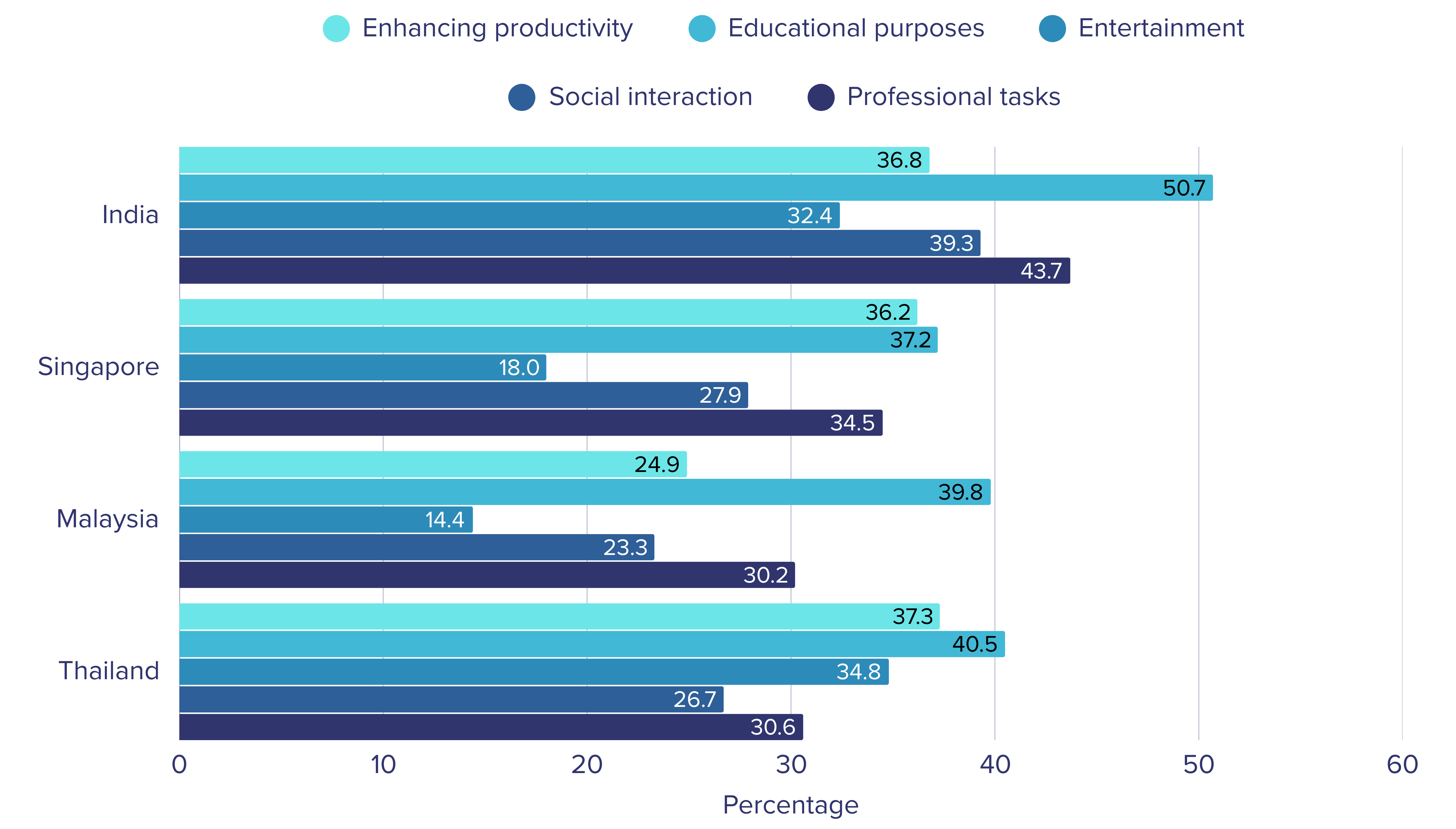
5. Confidence and Trust in AI Technologies
The data reveals striking differences in confidence and trust in AI technologies across the four countries. In terms of understanding AI, India leads with 44% of respondents stating they are "very confident." In contrast, the other three countries have the highest percentages of respondents indicating a "neutral" stance, reflecting significant uncertainty about their understanding of AI.
This lack of confidence appears to correlate with trust levels in AI technologies. India again stands out, with 22.3% of respondents saying they "fully trust" AI and an additional 37.9% indicating they "mostly trust" it. Most notably, respondents in Singapore (46.1%), Malaysia (52.8%), and Thailand (49.7%) show pronounced tendencies toward a "neutral" stance on trusting AI. These patterns suggest that greater confidence in understanding AI is linked to higher trust levels.
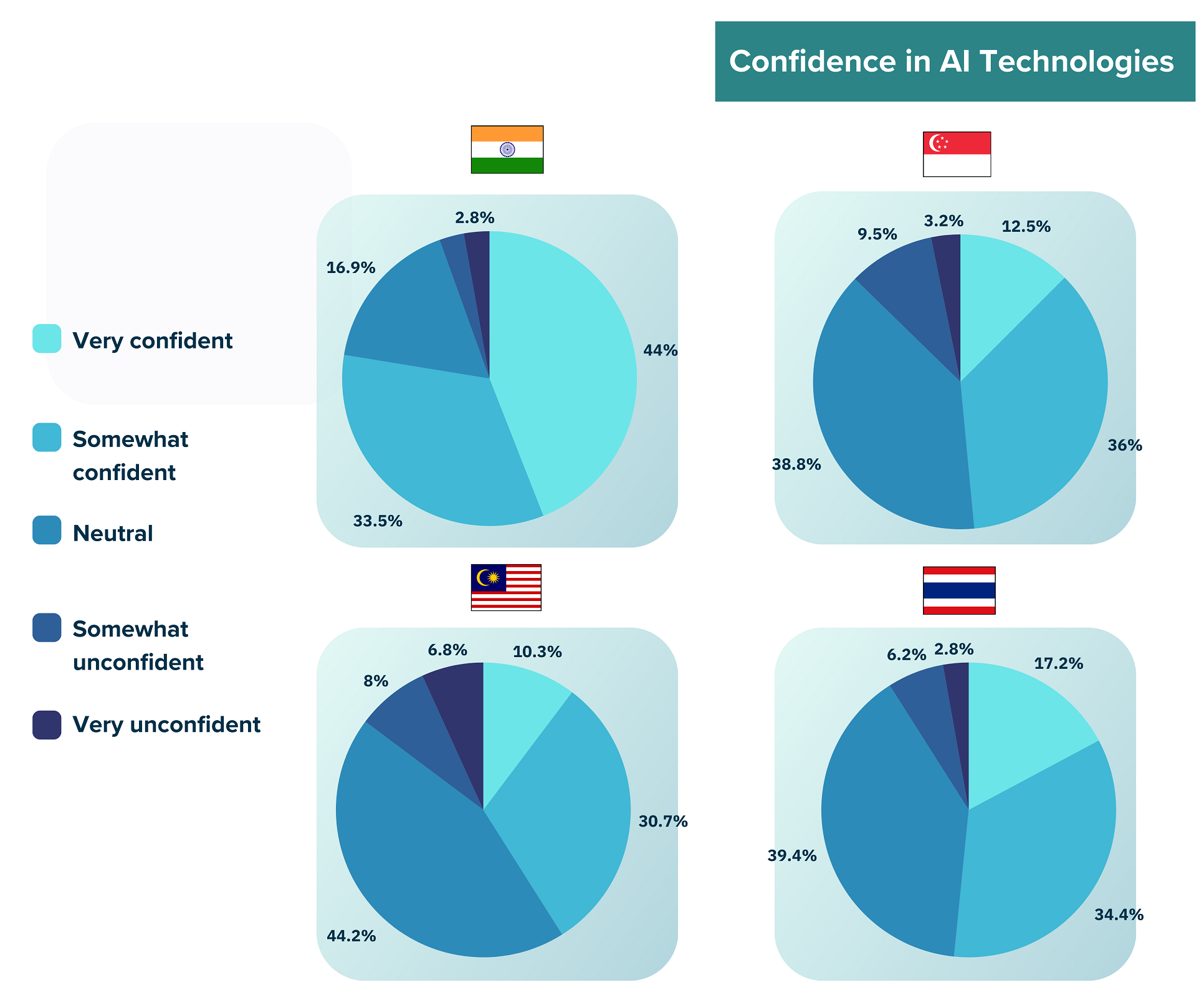
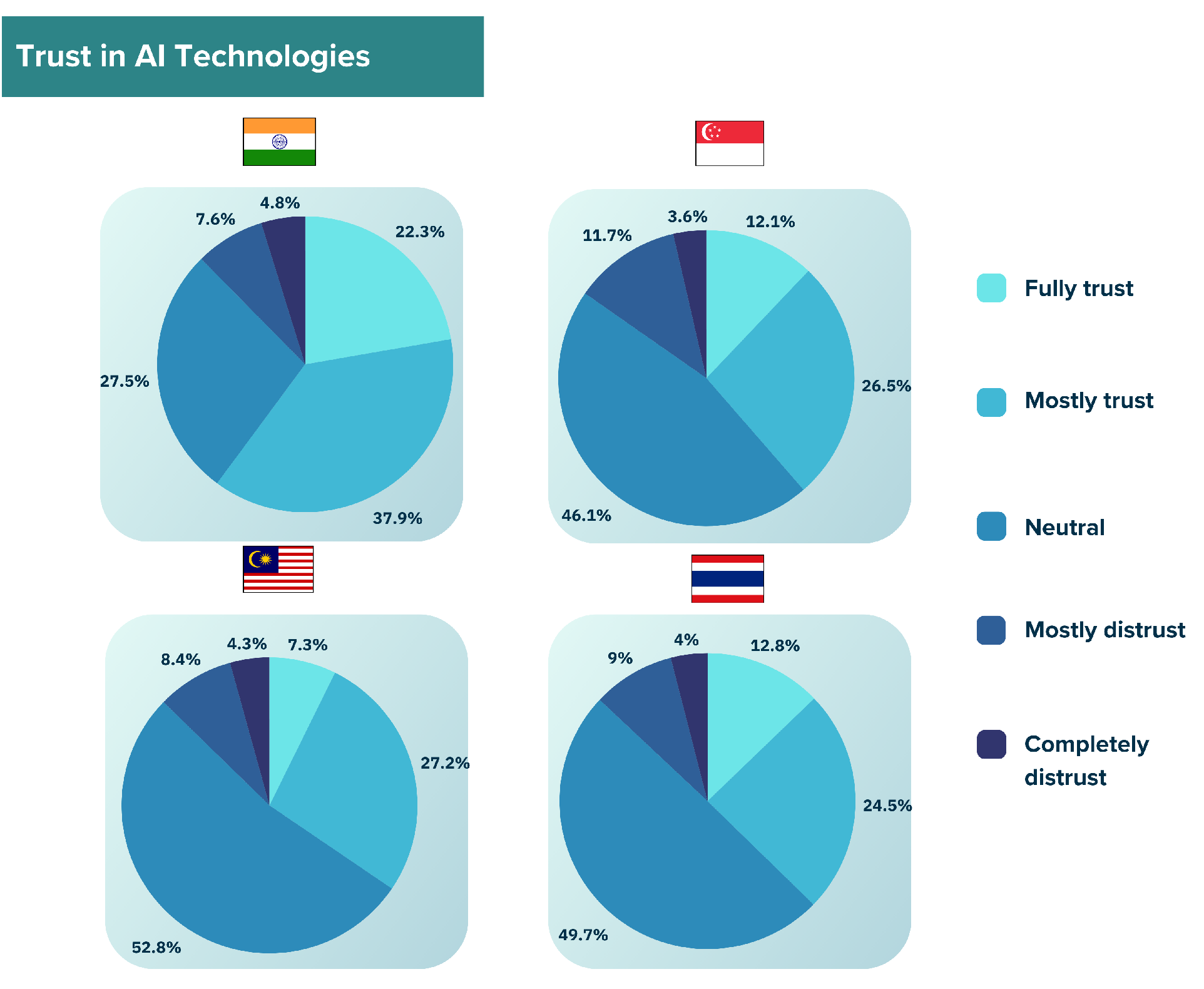
6. Concerns Regarding AI Tools
The survey reveals significant concerns about AI tools across four countries. Data Privacy and Security stands out as the top priority for respondents in all regions, with percentages exceeding 50% in each country.
In India, while Data Privacy and Security remains the foremost concern, respondents also express significant worry about Dependence on Technology, which emerges as the second greatest issue with 47.8%. Conversely, Singapore, Malaysia, and Thailand all identify Quality and Accuracy of AI-Generated Content as their second primary concern. Singapore stands out with the highest percentages for both Data Privacy and Security concerns (58%) and Quality and Accuracy of AI-Generated Content concerns (51.7%).

7. Tangible impacts of AI tools
India and Thailand report a positive outlook on productivity improvements from AI tools, with over 60% of respondents noting either a significant increase or a somewhat increased productivity. In contrast, Singapore and Malaysia express more cautious views, with lower percentages reporting similar increases (less than 50%). A significant portion of respondents in Singapore (approximately 36%) and Malaysia (27%) indicated no change in productivity. The older age demographic in Singapore likely plays a role in this hesitance, as older individuals may be less inclined to fully embrace innovative technologies, influencing their perception of productivity gains. Meanwhile, Malaysia's occupational background, which boasts a higher percentage of unemployed and retired individuals, further explains the subdued productivity outlook. This demographic detail suggests that those not engaged in the workforce may have less immediate exposure to AI tools and, consequently, a diminished perspective on their potential productivity benefits.
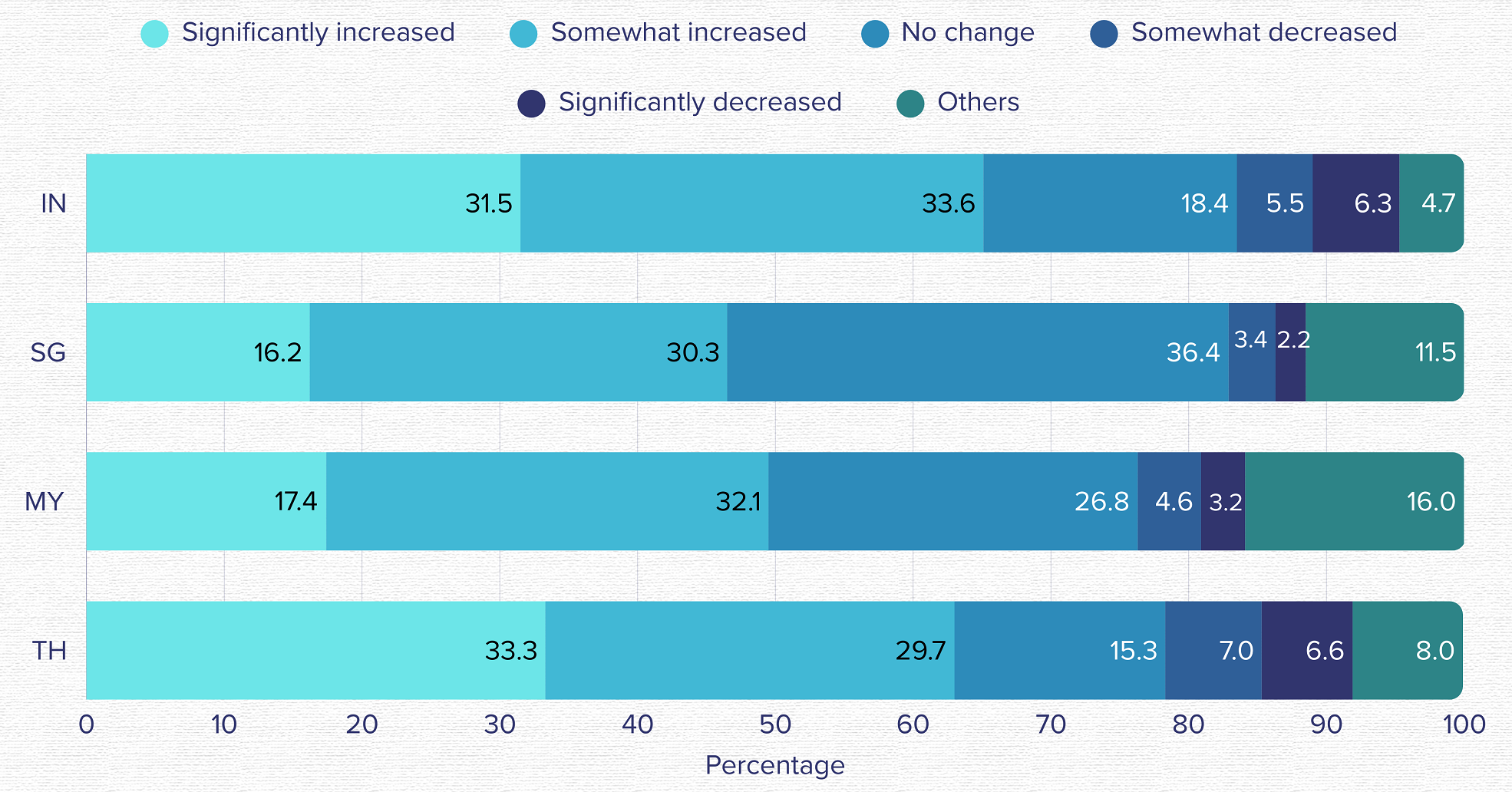
In terms of specific impacts, India stands out significantly in all areas of impact from AI tools. Respondents indicate improvements in work performance, learning and educational outcomes, communication (including faster responses and easier interactions), and creativity (in writing, art, and idea generation), with all metrics exceeding 44%—the highest percentages among the four countries.
Thailand follows closely behind, showing the second highest percentages in work performance, communication, and creativity. This trend aligns with its positive outlook on productivity improvements, as indicated by responses to the question about changes in workplace productivity. Both India and Thailand exhibit the most favourable perceptions regarding productivity enhancements from AI technologies.
In contrast, Singapore and Malaysia exhibit more modest impacts from AI tools across various areas. This trend is closely linked to the findings from the previous question, where a significant portion of respondents reported that AI has not notably enhanced productivity levels in their workplaces.

8. Factors Influencing AI Tool Adoption
When it comes to AI tool adoption, ease of use and user interface emerge as the most influential factors. This priority is particularly evident in Singapore, where 53.3% of respondents emphasize the importance of intuitive designs, followed closely by India at 48.5%, Thailand at 48.2%, and Malaysia at 46.6%. This focus on user-friendly interfaces highlights the critical need for AI solutions that facilitate accessibility and enhance the user experience.
Following closely in importance is the availability of features and functionalities. Thailand leads this aspect with 47.4%, while India is close behind at 44.6%. While the top two factors of ease of use and user interface, along with availability of features and functionalities, remain consistent across the countries, several other influencing criteria show notable variations.
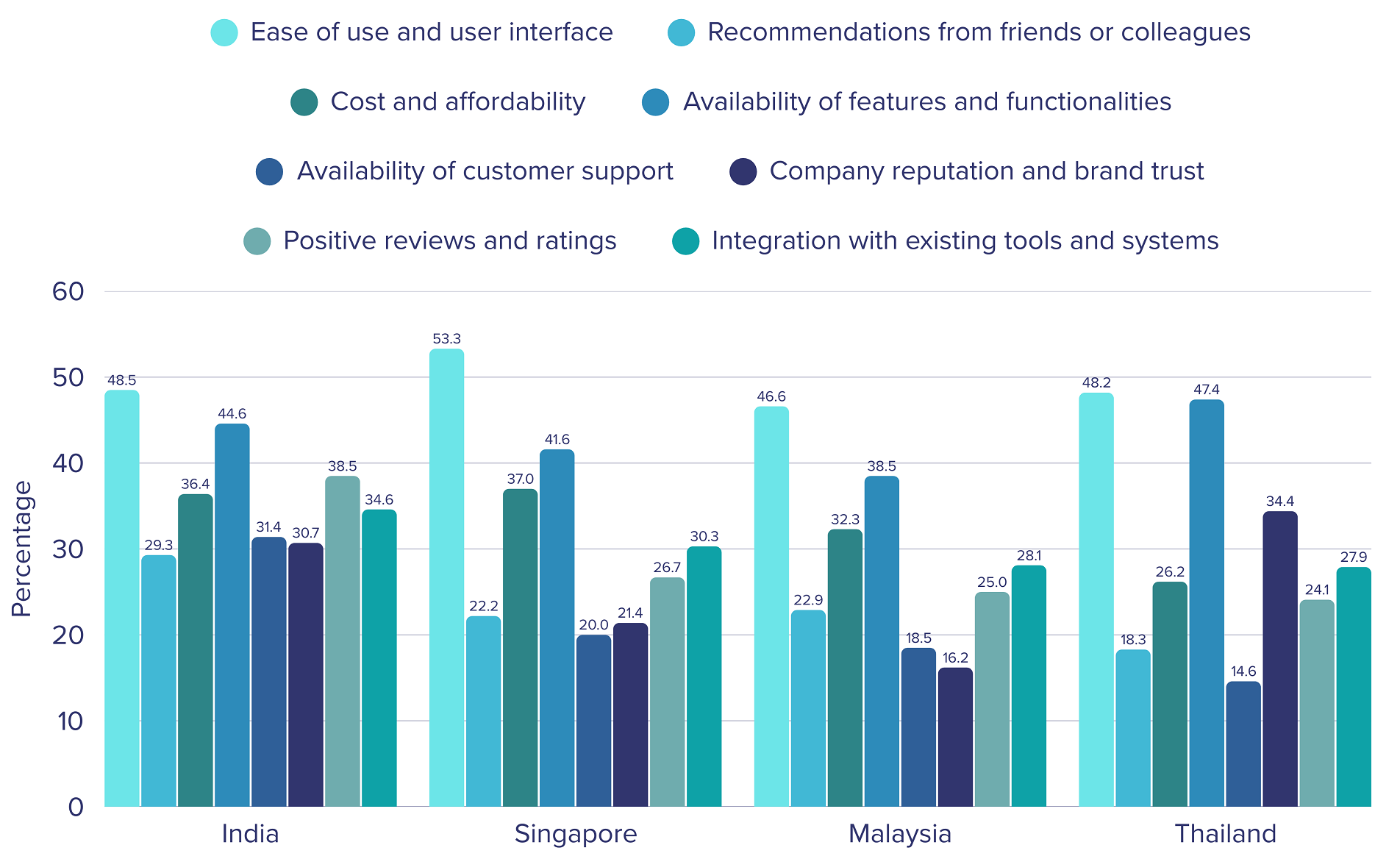
Conclusion: The Road Ahead for AI Tools
The findings from our analysis of the AI tools market across India, Singapore, Malaysia, and Thailand uncover a nuanced landscape of user engagement and preferences that calls for customized strategies. The trajectory of AI tools goes beyond simple functionalities; it focuses on the creation of adaptable, user-centered solutions that align with the ever-changing requirements of a tech-savvy audience. By recognizing and addressing these elements, stakeholders in the AI sector can tap into new opportunities, ensuring they effectively address the diverse needs of users and make significant contributions to their digital experiences.












